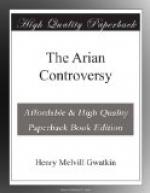CHAPTER IV.
THE COUNCIL OF SARDICA.
[Sidenote: Death of Constantine, May 22, 337.]
Constantine’s work on earth was done. When the hand of death was on him, he laid aside the purple, and the ambiguous position of a Christian Caesar with it, and passed away in the white robe of a simple convert. Long as he had been a friend to the churches, he had till now put off the elementary rite of baptism, in the hope one day to receive it in the waters of the Jordan, like the Lord himself. Darkly as his memory is stained with isolated crimes, Constantine must for ever rank among the greatest of the emperors; and as an actual benefactor of mankind, he stands alone among them. Besides his great services to the Empire in his own time, he gave the civilization of later days a new centre on the Bosphorus, beyond the reach of Goth or Vandal. Bulgarians and Saracens and Russians dashed themselves in pieces on the walls of Constantinople, and the [Sidenote: A.D. 1204.] strong arms of Western and crusading traitors were needed at last to overthrow the old bulwark which for so many centuries had guarded Christendom. Above all, it was Constantine who first essayed the problem of putting a Christian spirit into the statecraft of the world. Hard as the task is even now, it was harder still in times when the gospel had not yet had time to form, as it were, an outwork of common feeling against some of the grosser sins. Yet whatever might be his errors, his legislation was a landmark for ever, because no emperor before him had been guided by a Christian sense of duty.
[Sidenote: Division of the Empire.]
The sons of Constantine shared the Empire among them ’like an ancestral inheritance.’ Thrace and Pontus had been assigned to their cousins, Dalmatius and Hannibalianus; but the army would have none but Constantine’s own sons to reign over them. The whole house of Theodora perished in the tumult except two boys—Gallus and Julian, afterwards the apostate Emperor. Thus Constantine’s sons were left in possession of the Empire. Constantine II. took Gaul and Britain, the legions of Syria secured the East for Constantius, and Italy and Illyricum were left for the share of the youngest, Constans.
[Sidenote: Recall of Athanasius, 337.]
One of the first acts of the new Emperors was to restore the exiled bishops. Athanasius was released by the younger Constantine as soon as his father’s death was known at Trier, and reached Alexandria in November 337, to the joy of both Greeks and Copts. Marcellus and the rest were restored about the same time, though not without much disturbance at Ancyra, where the intruding bishop Basil was an able man, and had formed a party.
[Sidenote: Character of Constantius.]




